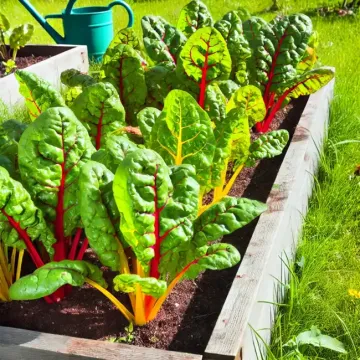Swiss chard (Beta vulgaris var. cicla), often simply called chard, is a leafy green vegetable known for its vibrant stalks, nutritious leaves, and adaptability in the garden. A close relative of the beet, Swiss chard is both ornamental and edible, making it a popular choice for home gardeners. Whether you're growing it for its rich color, high nutritional value, or versatile culinary uses, Swiss chard is an excellent addition to any home garden.
History of Swiss Chard
Despite its name, Swiss chard does not originate in Switzerland. The term "Swiss" was added in the 19th century by seed catalog publishers to distinguish it from French spinach varieties. Chard is native to the Mediterranean region and has been cultivated for thousands of years. Ancient Greeks and Romans grew it for both its medicinal properties and its culinary versatility. Today, it is a staple in Mediterranean cooking and is enjoyed around the world for its health benefits and ease of cultivation.
Health Benefits of Swiss Chard
Swiss chard is a nutritional powerhouse. It is rich in vitamins A, C, and K, as well as minerals such as magnesium, potassium, and iron. The leafy greens are also an excellent source of antioxidants, which help combat oxidative stress in the body. One of its standout nutrients is vitamin K, which supports bone health and blood clotting. Additionally, Swiss chard is low in calories but high in fiber, making it a great choice for maintaining a healthy diet.
Culinary Uses of Swiss Chard
Swiss chard is a versatile vegetable in the kitchen. Its slightly bitter leaves can be sautéed, steamed, or added to soups, stews, and casseroles. The colorful stalks, which range from white to vibrant shades of yellow, pink, and red, are also edible and can be cooked similarly to celery. In Mediterranean cuisine, Swiss chard is often used in dishes such as stuffed chard rolls, pasta dishes, and frittatas. The young, tender leaves can be eaten raw in salads, adding a nutritious and flavorful punch.
Growing Swiss Chard in the Home Garden
Swiss chard is a hardy, easy-to-grow vegetable that can thrive in various climates and soil conditions. Here's a guide to help you successfully grow Swiss chard in your home garden.
1. Site Selection: Swiss chard prefers a sunny location but can tolerate partial shade. It grows best in well-drained soil that is rich in organic matter. A pH range of 6.0 to 7.0 is ideal for optimal growth.
2. Planting: Swiss chard can be grown from seeds or transplants. Direct sow seeds in the garden about 2 to 3 weeks before the last frost date in your area, or start seeds indoors 4 to 6 weeks before transplanting. Space seeds or transplants about 6 to 12 inches apart in rows that are 18 to 24 inches apart. Chard can be planted in both spring and fall, as it can tolerate both cool and warm weather.
3. Watering: Swiss chard requires consistent moisture to thrive, so keep the soil evenly moist but not waterlogged. Mulching around the plants can help retain moisture and reduce the need for frequent watering.
4. Fertilization: Swiss chard is a heavy feeder and benefits from a nutrient-rich soil. Incorporate compost or well-rotted manure into the soil before planting. During the growing season, side-dress with a balanced fertilizer or apply liquid fertilizer every few weeks to promote healthy growth.
5. Pest and Disease Management: Swiss chard is generally resistant to many common garden pests and diseases, but it can still be affected by aphids, leaf miners, and fungal diseases like powdery mildew. Regularly inspect plants for signs of pests or disease and treat them promptly with organic solutions such as neem oil, insecticidal soap, or by removing affected leaves.
6. Harvesting: Swiss chard can be harvested as a "cut-and-come-again" crop. Begin harvesting outer leaves when they are large enough to use, typically when they reach 6 to 8 inches long. Allow the inner leaves to continue growing, and you can enjoy multiple harvests from the same plant throughout the growing season. In warmer climates, chard can be grown year-round.
Varieties of Swiss Chard
Swiss chard comes in several beautiful and colorful varieties, each with unique characteristics. Some popular varieties include:
- ‘Bright Lights’: Known for its vibrant, multicolored stalks, this variety adds a pop of color to the garden.
- ‘Fordhook Giant’: A classic variety with large, dark green leaves and thick white stems. It is known for its heat tolerance.
- ‘Rhubarb Chard’: This variety has deep red stems and dark green leaves with red veins, offering an attractive contrast.
- ‘Ruby Red’: Similar to ‘Rhubarb Chard,’ this variety has ruby-red stems and dark green leaves, adding both color and flavor to the garden.
Conclusion
Swiss chard is a fantastic vegetable to grow in the home garden due to its nutritional benefits, culinary versatility, and striking appearance. It is relatively easy to grow and maintain, making it suitable for gardeners of all skill levels. Whether you’re planting Swiss chard for its leafy greens or its decorative stalks, you’ll enjoy a bountiful harvest that can be used in a variety of dishes throughout the growing season.

